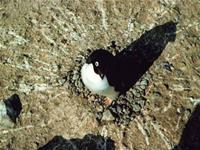 |
| Penguins and the “power push” around their nests |
The time has come again for the Ig Nobel Prizes, awarded for research that “first makes you laugh, and then makes you think,” which were announced in the U.S. on October 6.
The award-winning studies include calculations of the “internal force” of penguins when they relieve themselves; comparisons of swimming speeds in regular water versus syrup; and how long it takes tar to drip just one drop!
Swimming in syrup is just like swimming in water…
Edward Cussler and Brian Gettelfinger from the University of Minnesota won the Ig Nobel Prize in Chemistry for their rather “sporty” research. When Gettelfinger was a student training for the Olympics, he had the idea to test whether people swim faster in water or in syrup.
The two friends sought permission to experiment, needing to obtain approval from 22 different authorities before they could pour corn syrup into a 25-meter swimming pool.
However, the city of Minneapolis demanded $22,000 if they wanted to proceed with the experiment, citing concerns that the syrup would overwhelm the drainage system after the test!
They did not give up. Their final solution was to mix 310 kilograms of candy powder with water in the pool. Sixteen volunteers swam in the syrup mixture and then in regular water.
The results of the experiment were as “useless” as Cussler himself admitted: there was no difference at all; swimming in regular water or in syrup was equally fast or slow.
The “internal force” of penguins
Few people know, except for researchers, that penguins tend to avoid leaving their nests to relieve themselves when they are incubating eggs. When the need arises, a penguin simply leans forward, lifts its tail, and “fires away.”
The Ig Nobel Prize in Fluid Dynamics went to Benno Meyer-Rochow (International University of Bremen, Germany), a team from the University of Oulu in Finland, and Jozsef Gal (Eötvös Loránd University, Hungary) for their study showing that a penguin, given its size, can exert an “internal force” of between 10 to 60 kilopascals when relieving itself, much higher than the “internal force” exerted by humans during a similar task.
Why does the penguin choose not to find a separate spot to relieve itself but instead does it in the nest? One possible explanation is that it does not want its egg to get cold.
The runaway clock
This year’s Ig Nobel Prize in Literature was awarded for a scam email from Nigeria, which cleverly and systematically tells the story of a treasure that belongs to the sender and promises a reward to anyone who helps them retrieve it.
Many people in Vietnam may have received this award-winning “work”! The Economics Prize was even more unusual: Gauri Nanda (MIT, USA) won for inventing a special alarm clock, considered a contribution to the economy. This clock, named Clocky, is equipped with wheels.
When it goes off and the groggy owner hits the snooze button, Clocky immediately “runs away” on its wheels, “hiding” somewhere to ring again.
The owner has no chance to reach out and turn it off again, theoretically forcing them to get out of bed, go to work on time, and… contribute to the economy.
A multi-generational experiment
The experiment that won the Ig Nobel Prize in Physics this year can accurately be called a multi-generational experiment. Pitch is still considered a liquid, but its properties are akin to a solid. Thomas Parnell (University of Queensland, Australia) devised a method to prove that pitch is indeed a liquid. He poured pitch into a funnel, where it solidified.
Then he sat… and waited for it to drip down, because a liquid should drip, right? This experiment began in 1927. Eight years later, the first drop finally fell. The second drop fell exactly nine years after that.
Now Parnell has passed away, and researcher John Mainstone continues the experiment. Just last year, the pitch dripped for the eighth time, and Mainstone is waiting for the ninth drop to fall.
The Ig Nobel Prizes 2005
* Biology: Benjamin Smith (University of Adelaide, Australia) and his team studied the different odors emitted by frogs when stressed. The conclusion: some emit scents reminiscent of cashews, licorice, peppermint, or rotting fish.
* Fluid Dynamics: Victor Benno Meyer-Rochow (International University of Bremen, Germany) won for researching the internal pressure exerted by penguins when they relieve themselves.
* Physics: Since 1927, researchers at the University of Queensland, Australia, have demonstrated that pitch is a liquid by placing it in a funnel and waiting for it to flow down. This year, the pitch is about to drip for the ninth time. This experiment holds the Guinness World Record for the longest-running experiment in the world.
* Peace: Two researchers from Newcastle upon Tyne, England, won for studying the effects of scenes from Star Wars on the brains of… grasshoppers.
* Chemistry: Research from the University of Minnesota (USA) showed that swimming speeds in syrup are equivalent to swimming speeds in regular water.
* Literature: Nigerian “authors” won for their scam email sent to millions worldwide, asking for a small fee to help them recover a vast treasure and share the proceeds. Such emails have also appeared in Vietnam.
* Medicine: The award went to Gregg Miller for inventing “Neuticles,” a type of… artificial testicle that can be used for… neutered dogs.
* Nutrition: Dr. Yoshiro Nakamats has spent 35 years photographing his meals to study the effects of food on brain function, health, and longevity. He identified 55 factors that could help a person live to 144 years old.
* Economics: The Clocky alarm clock, created by Gauri Nanda (MIT, USA).
HÀ NGUYÊN (compiled)


















































